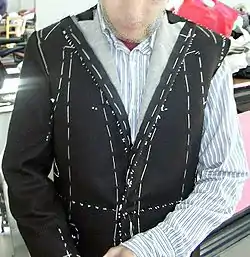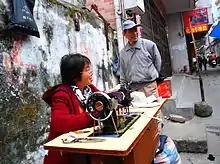Tailor
A tailor is a person who makes, repairs, or alters clothing professionally, especially suits and men's clothing.


Although the term dates to the thirteenth century, tailor took on its modern sense in the late eighteenth century, and now properly refers to makers of men's and women's suits, coats, trousers, and similar garments, commonly of wool, linen, or silk.
The term so used thus refers to a set of specific hand and machine sewing and pressing techniques that are unique to the construction of traditional jackets. Small and medium size retail tailors often provide their services internationally, with individual tailors and cutters travelling to various cities, allowing the customers to be met locally, measured on one trip, fitted on another and thereafter supplied with (a) garment(s) without the inconvenience of themselves travelling overseas. Even small tailoring businesses without an international following will sometimes travel from one city to another within their home country, and quite a number will visit customers at the customers' places of work or homes.
Traditional tailoring is called "bespoke tailoring" in the United Kingdom, where the heart of the trade is London's Savile Row tailoring, and "custom tailoring" in the United States and Hong Kong. This is unlike made to measure which starts by using pre-existing patterns within which relatively few individual style preferences can be satisfied. A true bespoke garment or suit is completely original and unique to each customer. However, the term 'bespoke' is widely used by makers of garments not within the strict original definition of the term and the legal battle to prevent what was once regarded as a misuse of the description has now been lost.
Famous fictional tailors include the tailor in The Tailor of Gloucester, The Emperor's New Clothes and The Valiant Little Tailor. A more recent example is John le Carré's The Tailor of Panama.
Types
.jpg.webp)

As the tailoring trade has evolved, so too have the methods of tailoring. There are a number of distinctive business models which modern tailors may practise. While some may practise many, there are others who will practise only one or two. Moreover, many tailoring houses, particularly in parts of Western Europe (including the UK) have distinctive individual styles for which they are well known by the better informed users of tailoring services.
Local tailoring
Local tailoring is as the name implies. Typically the tailor is met locally and the garment produced locally. This method enables the tailor to take professional measurements, assess posture and body shape to make unique modifications to the garment. Local tailors will typically have a showroom or shopfront allowing clients to choose fabrics from samples or return the garment easily should it require further modification. This is the most traditional form of tailoring. Hong Kong Tailors and London are the most famous for high quality bespoke tailoring. It typically takes some two or three fittings and about 50 to 70 working hours to handmake one suit. However, in England (as in Italy and France), the best of bespoke suits may involve a wait of several weeks from first fitting to final supply, whereas the process in the Far East is often very much faster.
Distance tailoring


Distance tailoring involves ordering a garment from an out-of-town tailor enabling cheaper labour to be used. In practice this can now be done on a global scale via e-commerce websites. Unlike local tailoring, customers must take their own measurements, fabric selection must be made from a photo and if further alterations are required the garment must be shipped. Today, the most common platform for distance tailoring is via online tailors.
Online tailors sometimes offer to pay for needed alterations at a local tailor. Another new option is the concept where a free suit mock-up is made to the provided measurements and shipped to the customer first. The suit mock-up can be tried on and worn to see where any adjustments are wanted. The final suit is then tailored to the new specifications provided by the suit mock-up fitting.
Traveling tailor
Unlike tailors who do distance tailoring, traveling tailors provide a more personal service to their customers and give the customers an opportunity to see the fabric samples and meet the tailor in person. Traveling tailors travel between cities and station in a local luxury hotel for a short period of time to meet and provide the same tailoring services they would provide in their local store. In the hotel, the customer will be able to select the fabric from samples and the tailor will take the measurements himself. The order then will be shipped to the customer within 3–4 weeks. Unlike local tailoring, if further alterations are required the garment must be shipped. Today, most traveling tailors are from Hong Kong, traveling to the United States, the United Kingdom, France, Australia and Japan.
Economics
There are many gradations within the tailoring industry. The prices charged for genuine bespoke tailoring by Savile Row tailors, like those charged by leading haute couturiers in Paris, are well beyond the budget of most ordinary working people, even those from rich countries. Fortunately, mass-produced factory made 'tailored' clothing, while of inferior quality to such artisanal masterpieces, is invariably priced to be within the budget of many more modest wearers.
Related terms

- A tailor-made is a man's suit consisting of a (usually) woolen or tweed coat and pants; the name arose during the Edwardian period.
- As an adjective, tailor-made (from the second half of the twentieth century usually simplified to tailored) refers to clothing made by or in the style of clothes made by a tailor, characterized by simplicity of cut and trim and fine (often hand) finishing; as a women's clothing style tailored as opposed to dressmaker.
- Rodeo tailor is a term for a creator of the flamboyant costumes typical of country and western musicians, characterized by extensive hand embroidery, an abundance of rhinestones, and cowboy details such as pearl snaps and arrowhead pockets.
- In some contexts, the verb 'to tailor' means to adjust, and tailoring means adjusting.
Sewing professional is the most general term for those who make their living by sewing, teaching, writing about sewing, or retailing sewing supplies. They may work out of their home, a studio, or retail shop, and may work part-time or full-time. They may be any or all or the following sub-specialties:
- A custom clothier makes custom garments one at a time, to order, to meet an individual customer's needs and preferences.
- A custom dressmaker specializes in women's custom apparel, including day dresses, suits, evening or bridal wear, sportswear, or lingerie.
- A tailor makes custom menswear-style jackets and trousers.
- A cutter cuts out, from lengths of cloth, the panels that make up a suit. In bespoke tailoring, the cutter may also measure the client, advise them on style choices, and commission craftsmen to sew the suit.[2]
- An alterations specialist, or alterationist adjusts the fit of completed garments, usually ready-to-wear, or restyles them. Note that while all tailors can do alterations, not all alterationists can do tailoring.
- Designers conceive combinations of line, proportion, color, and texture for intended garments. They may or may not have sewing or patternmaking skills, and may only sketch or conceptualize garments. They work with people who know how to actually construct the garment.
- Patternmakers flat draft the shapes and sizes of the numerous pieces of a garment by hand, using paper and measuring tools or by computer using AutoCAD based software, or by draping muslin onto a dressform. The resulting pattern pieces must comprise the intended design of the garment and they must fit the intended wearer.
- A wardrobe consultant, fashion advisor, or stylist recommends styles and colors that are flattering to a client.
- A seamstress is someone who sews seams or a machine operator in a factory who may not have the skills to make garments 'from scratch' or to fit them onto a real body. This term is not a synonym for dressmaker. Seamstress is also an unkind and archaic euphemism for prostitute. Despite such unfortunate double meanings, a good seamstress can perform invaluable work within a hand tailoring business.
Tailor as a surname

The craft's denomination, Tailor, is a common surname in many languages: Taylor (English), Couturier (French), Schroeder, Schneider, and Schneiderman (German), Sarti (Italian), Siuvejas (Lithuanian), Szabó (Hungarian), Croitor (Romanian), Sastre (Spanish), Krawiec (Kravitz) (Polish), Portnov, Kravtsov (Russian), Krejčí (Czech), Darzi (Hindi/Urdu), Snijder, Kleermaker(s) (Dutch), Alfaiate (Portuguese), Khayat / خياط (Arabic), Chait / חייט (Hebrew), Raftis /Ράφτης (Greek), Kravets, Kravchuk, and Kravchenko (Ukrainian), Terzi (Turkish). In the movie Meeting Venus (written and directed by István Szabó), many of the characters have the cognates ("blood relative") of the surname Tailor from different languages.
Though unrelated to the procedure of tailoring, the similar sounding name Tyler was derived from the tiler profession.
See also
References
- "House of Dapper tailors". House of Dapper. 2019.
- "St James Style: Cad and the Dandy's London Cut | Men's Style and Lifestyle Blog". Stjames-style.blogspot.com. 2010-05-26. Retrieved 2014-02-06.
- Deckert, Barbara: Sewing for Plus Sizes: Design, Fit and Construction for Ample Apparel, Taunton, 1999, Appendix B: How to Find, Select, and Work With a Custom Clothier, pp. 142–143.'Meru'(Merollu_plural)(Telugu language of Telangana in A.P.)
External links
| Look up tailor in Wiktionary, the free dictionary. |
| Wikiquote has quotations related to: Tailors |
| Wikimedia Commons has media related to Tailors. |

